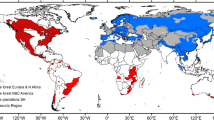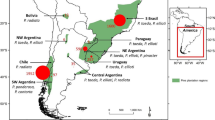Abstract
Although invasion of exotic ambrosia beetles (fungus feeders) and bark beetles (phloem feeders) (Coleoptera: Curculionidae: Scolytinae) is considered a major threat to forest health worldwide, no studies have quantitatively investigated the anthropogenic and environmental factors shaping the biogeographical patterns of invasion by these insects across large spatial scales. The primary aim of this study was to assess the relative importance of international trade and several environmental variables of the recipient region on species richness of established exotic Scolytinae. As a reference, we also evaluated the relationships between the same environmental variables and species richness of native Scolytinae. Using an information-theoretic framework for model selection and hierarchical partitioning, we evaluated the relative importance of the potential drivers of species richness of native and exotic Scolytinae in 20 European countries and the 48 contiguous continental US states. Analyses were conducted separately for ambrosia and bark beetle species. Value of imports was a strong predictor of the number of exotic Scolytinae species in both regions. In addition, in the USA, warmer and wetter climate was positively linked to increased numbers of both native and exotic ambrosia beetles. Forest heterogeneity and climatic heterogeneity and secondarily forest area were key drivers in explaining patterns of species richness for native bark beetles but not for exotic species in both regions. Our findings suggest that if current infestation levels continue on imported plants and wood packaging material, increasing international trade will likely lead to more establishments of exotic Scolytinae with concomitant negative effects on forest health in both Europe and the USA. Compared to Europe the risk of invasion appears higher in the USA, especially for ambrosia beetles in the southeastern USA where the climate appears highly suitable for exotic establishment.




Similar content being viewed by others
References
Aukema JE, McCullough DG, Von Holle B, Liebhold AM, Britton K, Frankel SJ (2010) Historical accumulation of nonindigenous forest pests in the continental US. Bioscience 60:886–897
Barton K (2010) MuMIn: multi-model inference R package version 01317
Bright DE, Skidmore RE (1997) A Catalog of Scolytidae and Platypodidae (Coleoptera) Supplement 1 (1990–1994). National Research Council Press, Ottawa
Bright DE, Skidmore RE (2002) A Catalog of Scolytidae and Platypodidae (Coleoptera) Supplement 2 (1995–1999). National Research Council Press, Ottawa
Brockerhoff EG (2009) Wood borer and bark beetle risk analysis. Scion report no 16833 for New Zealand Forest Biosecurity Research Council Scion, Rotura, New Zealand
Brockerhoff EG, Bain J, Kimberley M, Knížek M (2006a) Interception frequency of exotic bark and ambrosia beetles (Coleoptera: Scolytinae) and relationship with establishment in New Zealand and worldwide. Can J Forest Res 36:289–298
Brockerhoff EG, Jones DC, Kimberley MO, Suckling DM, Donaldson T (2006b) Nationwide survey for invasive wood–boring and bark beetles (Coleoptera) using traps baited with pheromones and kairomones. Forest Ecol Manag 228:234–240
Burnham KP, Anderson DR (2002) Model selection and multimodel inference, A practical information–theoretic approach. Springer, Berlin
Byers JA (1989) Behavioral mechanisms involved in reducing competition in bark beetles. Holarctic Ecol 12:466–476
Chevan A, Sutherland M (1991) Hierarchical partitioning. Am Stat 45:90–96
Cognato AI, Barc N, Philip M, Mech R, Smith AD, Galbraith E, Storer AJ, Kirkendall LR (2009) The native and introduced bark and ambrosia beetles of Michigan (Coleoptera: Curculionidae, Scolytinae). Great Lakes Entomol 42:101–120
Colunga-Garcia M, Haack RA, Adelaja AO (2009) Freight transportation and the potential for invasions of exotic insects in urban and periurban forests of the United States. J Econ Entomol 102:237–246
Colunga-Garcia M, Magarey RA, Haack RA, Gage SH, Qi J (2010) Enhancing early detection of exotic pests in agricultural and forest ecosystems using an urban–gradient framework. Ecol Appl 20:303–310
Coulson RN (1979) Population dynamics of bark beetles. Ann Rev Entomol 24:417–447
Coulston JW, Koch FH, Smith WD, Sapio FJ (2008) Invasive forest pest surveillance: survey development and reliability. Can J Forest Res 38:2422–2433
Currie DJ (1991) Energy and large–scale patterns of animal–and plant–species richness. Am Nat 137:27–49
DAISIE (2009) Handbook of alien species in Europe. Springer, Dordrecht
EEA (2007) European forest types categories and types for sustainable forest management reporting and policy. European Environment Agency. Technical report 9
Essl F, Dullinger S, Rabitsch W, Hulme PE, Hülber K, Jarošík V, Kleinbauer I, Krausmann F, Kühn I, Nentwig W, Vilà M, Genovesi P, Gherardi F, Desprez-Lousteau ML, Roques A, Pyšek P (2011) Socioeconomic legacy yields an invasion debt. P Natl Acad Sci USA 108:203–207
Furniss RL, Carolin VM (1977) Western forest insects. U.S. Department of Agriculture, Forest Service. Misc. Publ. 1339. Washington, DC
Gandhi KJK, Herms DA (2010) Direct and indirect effects of alien insect herbivores on ecological processes and interactions in forests of eastern North America. Biol Invasions 12:389–405
Haack RA (2001) Intercepted Scolytidae (Coleoptera) at US ports of entry: 1985–2000. Integr Pest Manag Rev 6:253–282
Haack RA (2006) Exotic bark–and wood–boring Coleoptera in the United States: recent establishments and interceptions. Can J Forest Res 36:269–288
Haack RA, Petrice TR (2009) Bark–and wood–borer colonization of logs and lumber after heat treatment to ISPM 15 specifications: the role of residual bark. J Econ Entomol 102:1075–1084
Haack RA, Rabaglia RJ (2011) Exotic bark and ambrosia beetles (Coleoptera: Curculionidae: Scolytinae) in the United States: potential and current invaders. In: Peña JE (ed) Potential invasive pests of agricultural crop species. CAB International, Wallingford, UK
Haack RA, Hérard F, Sun J, Turgeon JJ (2010) Managing invasive populations of Asian longhorned beetle and citrus longhorned beetle: a worldwide perspective. Ann Rev Entomol 55:521–546
Haack RA, Uzunovic A, Hoover K, Cook JA (2011) Seeking alternatives to probit 9 when developing treatments for wood packaging materials under ISPM No. 15. EPPO Bull 41:39–45
Hijmans RJ, Cameron SE, Parra JL, Jones PG, Jarvis A (2005) Very high resolution interpolated climate surfaces for global land areas. Int J Climatol 25:1965–1978
Holmes TP, Aukema JE, Betsy VH, Liebhold A, Sills E (2009) Economic impacts of invasive species in forests: past, present, and future. Ann NY Acad Sci 1162:18–38
Huston M (1979) A general hypothesis of species diversity. Am Nat 113:81–101
Kirkendall LR (1983) The evolution of mating systems in bark and ambrosia beetles (Coleoptera: Scolytidae and Platypodidae). Zool J Linn Soc–Lond 77:293–352
Kirkendall LR, Faccoli M (2010) Bark beetles and pinhole borers (Curculionidae, Scolytinae, Platypodinae) alien to Europe. ZooKeys 56:227–251
Knížek M (2004) Scolytinae Fauna Europaea: curculionidae. Fauna Europaea version 13. In: Alonso Zarazaga MA (ed). http://www.faunaeur.org. Accessed 23 Mar 2010
Knížek M (2011) Scolytinae. In: Löbl I, Smetana A (eds.) Catalogue of palaearctic Coleoptera, Vol 7. Apollo Books, Stenstrup, Denmark, pp. 86–87, p. 204–251
Koch FH, Yemshanov D, Colunga-Garcia M, Magarey RD, Smith WD (2010) Potential establishment of alien-invasive forest insect species in the United States: where and how many? Biol Invasions 13:969–985
Langor DW, DeHaas LJ, Foottit RG (2009) Diversity of non–native terrestrial arthropods on woody plants in Canada. Biol Invasions 11:5–19
Liebhold AM, Tobin PC (2008) Population ecology of insect invasions and their management. An Rev Entomol 53:387–408
Lockwood JL, Cassey P, Blackburn T (2009) The more you introduce the more you get: the role of colonization pressure and propagule pressure in invasion ecology. Divers Distrib 15:904–910
Lu M, Miller DR, Sun JH (2007) Cross-attraction between an exotic and a native pine bark beetle: a novel invasion mechanism? PLoS ONE 12:e1302
Mac Nally R, Walsh C (2004) Hierarchical partitioning public–domain software. Biodivers Conserv 13:659–660
MacArthur RH, Wilson EO (1967) The theory of island biogeography. Princeton University Press, Princeton
McCullough DG, Work TT, Cavey JF, Liebhold AM, Marshall D (2006) Interceptions of nonindigenous plant pests at US ports of entry and border crossings over a 17–year period. Biol Invasions 8:611–630
Milbau A, Stout JC, Graae BJ, Nijs I (2009) A hierarchical framework for integrating invasibility experiments incorporating different factors and spatial scales. Biol Invasions 11:941–950
Murray K, Conner MM (2009) Methods to quantify variable importance: implications for the analysis of noisy ecological data. Ecology 90:348–355
NOBANIS (2010) European network on invasive alien species. http://www.nobanis.org/. Accessed 23 Mar 2010
Piel F, Gilbert M, De Canniere C, Gregoire JC (2008) Coniferous round wood imports from Russia and Baltic countries to Belgium A pathway analysis for assessing risks of exotic pest insect introductions. Divers Distrib 14:318–328
Pyšek P, Jarošík V, Hulme PE, Kühn I, Wild J et al (2010) Disentangling the role of environmental and human pressures on biological invasions across Europe. P Natl Acad Sci USA 107:12157–12162
Rabaglia RJ, Dole SA, Cognato AI (2006) Review of American Xyleborina (Coleoptera: Curculionidae: Scolytinae) occurring North of Mexico, with an illustrated key. An Entomol Soc Am 99:1034–1056
Rabaglia RJ, Duerr D, Acciavatti R, Ragenovich I (2008) Early detection and rapid response for non-native bark and ambrosia beetles. USDA–Forest Service, Forest Health Protection, Washington
Roques A, Rabitsch W, Rasplus JY, Lopez-Vaamonde C, Nentwig W, Kenis M (2009) Alien terrestrial invertebrates of Europe. In: SE DAI (ed) Handbook of alien species in Europe. Springer. Springer, Dordrecht, pp 63–79
Rosenzweig ML (1995) Species diversity in space and time. Cambridge University Press, Cambridge
Roura-Pascual N, Hui C, Ikeda T, Leday G, Richardson D, Carpintero S et al (2011) The relative roles of climatic suitability and anthropogenic influence in determining the pattern of spread in a global invader. P Natl Acad Sci USA 108:220–225
Sauvard D, Branco M, Lakatos F, Faccoli M, Kirkendall L (2010) Weevils and bark beetles–Coleoptera, Curculionoidea. BioRisk 4:219–266
Simberloff D (2009) The role of propagule pressure in biological invasions. Ann Rev Ecol Evol S 40:81–102
Stevens GC (1986) Dissection of the species–area relationship among wood–boring insects and their host plants. Am Nat 128:35–46
Stohlgren TJ, Barnett D, Kartesz J (2003) The rich get richer: patterns of plant invasions in the United States. Frontiers Ecol Environ 1:11–14
R Development Core Team (2011) R: a language and environment for statistical computing R foundation for statistical computing, Vienna, Austria ISBN 3–900051–07–0, URL http://wwwR–projectorg
USDA–FS (US Department of Agriculture–Forest Service) (2010) Forest inventory data online (FIDO) Version 131r0. http://fiatools.fs.fed.us/fido/index.html. Accessed 27 Aug 2010
Walther GR, Roques A, Hulme PE, Sykes MT, Pyšek P, Kühn I, Zobel M et al (2009) Alien species in a warmer world: risks and opportunities. Trends Ecol Evol 24:686–693
Williams DW, Liebhold AM (2002) Climate change and the outbreak ranges of two North American bark beetles. Agr Forest Entomol 4:87–99
Wood SL (1977) Introduced and exported American Scolytidae (Coleoptera). Great Basin Nat 37:67–74
Wood SL (1982) The bark and ambrosia beetles of North and Central America (Coleoptera: Scolytidae), a taxonomic monograph. Great Basin Nat Memoirs 6:1–1359
Wood SL, Bright DE (1992) A catalog of Scolytidae and Platypodidae (Coleoptera), Part 2: taxonomic index. Great Basin Nat Memoirs 13:1–1553
Work T, McCullough D, Cavey J, Komsa R (2005) Arrival rate of non–indigenous insect species into the United States through foreign trade. Biol Invasions 7:323–332
Acknowledgments
This study was supported by the PRATIQUE project (Enhancements of Pest Risk Analysis Techniques) financed through the EU Seventh Research Framework Program (FP7) (Contract No 212459). We thank two anonymous reviewers for the constructive comments that greatly improved early versions of the manuscript; M. Colunga-Garcia, J. LaBonte, D.R. Miller, T.M. Poland, and A. Roques for providing insightful comments and suggestions on earlier versions of the manuscript; M. Knížek and A. Cognato for sharing unpublished data; L. Garrett for providing US economic data; and the many participants of the USDA, Forest Service, Early Detection and Rapid Response project for access to the US Scolytinae collection data for 2007–2010.
Author information
Authors and Affiliations
Corresponding author
Rights and permissions
About this article
Cite this article
Marini, L., Haack, R.A., Rabaglia, R.J. et al. Exploring associations between international trade and environmental factors with establishment patterns of exotic Scolytinae. Biol Invasions 13, 2275–2288 (2011). https://doi.org/10.1007/s10530-011-0039-2
Received:
Accepted:
Published:
Issue Date:
DOI: https://doi.org/10.1007/s10530-011-0039-2




